At Mission Control for Endeavour’s last flight
At Mission Control for Endeavour’s last flight
| Author: | Lisa Hunt Tally |
|---|---|
| Magazine Section: | Always |
| College or School: | CoE |
| Article Type: | Issue Feature |
| Page CSS: | .sidebar.right {
top: -1200px; } |
| Feature Intro: | When Endeavour blasted into space on its final shuttle flight (STS-134), flight director Gary Horlacher (BSIDE ’89) was at work in NASA’€™s Mission Control Center in Houston, orchestrating teams of specialists in behind-the-scenes work. |
A graduate of Purdue’s Interdisciplinary Engineering program (now part of the School of Engineering Education), Horlacher likens the flight director’s role to that of an orchestra conductor — in his case, one who’s steeped in systems engineering.
“It’s my job,” he says, “to lead the flight control team in the right direction and keep us on track. It’s a very dynamic environment, and you’re constantly trading off risk versus reward.” Crew safety and mission success are in his hands.
Horlacher’s work on mission STS-134 combined the usual concerns — will the shuttle team get the flight done properly and safely? — with the bittersweet recognition that an iconic American space initiative is over. “I can’t believe Endeavour is no longer going to leave the planet,” he says. “She flew a great mission.” Atlantis’ July flight marked the end of the shuttle program.
Endeavour’s payloads included the Alpha Magnetic Spectrometer (AMS) and STORRM, a system for automatically docking a craft with the International Space Station.
“Getting the AMS to its final destination on the International Space Station was an incredibly rewarding moment,” Horlacher says. Created over nearly a decade through a collaboration of 600 scientists around the world, the instrument was activated and almost immediately began detecting cosmic particles. “Since then,” Horlacher says, “scientists have detected billions of particles. We are going to learn a lot about the universe and our place in it thanks to the AMS.”
As for STORMM (Sensor Test for Orion Relative Navigation Risk Mitigation), “we tested the system,” he says. “It’s a pair of advanced-technology sensors that are being designed for future spacecraft to rendezvous and dock in space. We can reduce a lot of risk by testing it in space before you need to rely on it for an actual rendezvous and docking.”
STS-134 also featured four spacewalks. Horlacher says that spacewalks are anything but routine. “Getting the astronaut into the spacesuit — which is like another spaceship — and sending them outside into the space environment is always tense for me. On spacewalk number 2 the astronauts were working with ammonia lines with a history of leaking, and ammonia is not a nice material. That was by far the most stressful day.”
During spacewalk 3, shuttle crew members removed some panels in order to relubricate one of the solar-array rotary mechanisms, and several of the captive bolts released and started to float away. “The crew caught a couple,” Horlacher says, “but a few got away — a helpless feeling since it was completely unexpected. There’s nothing you can do but watch.”
On hand in Florida for Endeavour’s landing, Horlacher will now turn his attention to training for service as a flight director for the International Space Station. He is also assigned to assist Boeing in its efforts to build the capability to get crew and cargo to and from low earth orbit.
In the midst of uncertainty within NASA and the aerospace industry, Horlacher sees a tremendous amount of opportunity for students who want to get into the field.
“A lot of commercial companies are doing cool aerospace work,” he says. “Some want to fly tourists; some want to get astronauts to the space station. Flexibility is the key in a dynamic environment. Generally in chaos comes opportunity, and you’ve got to grab it.”
Joint event to explore history, future of spaceflight
To celebrate the 50th anniversary of human spaceflight, a joint event between the colleges of Engineering and Liberal Arts will be held at 3:30 p.m. Nov. 10 in the Neil Armstrong Hall Atrium. Gary Horlacher, NASA flight director, and Michael G. Smith, associate professor of history, will discuss the geopolitical and societal context and technological challenges of the space race between the U.S. and the Soviet Union in the early 1960s, explore the much more complex nature of the human and technological systems in the space shuttle era, and ask what lessons we can learn from this for the future of human exploration of space.
Seminar details are available on the Engineering Education website.

Comments